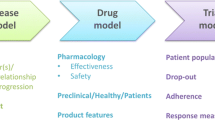Abstract
It is a well-known fact that clinical trials is a challenging process essentially for financial, ethical, and scientific concern. For twenty years, simulated clinical trials (SCT for short) has been introduced in the drug development. It becomes more and more popular mainly due to pharmaceutical companies which aim to optimize their clinical trials (duration and expenses) and the regulatory agencies which consider simulations as an alternative tool to reduce safety issues. The whole simulation plan is based on virtual patients generation. The natural idea to do so is to perform Monte Carlo simulations from the joined distribution of the covariates. This method is named Discrete Method. This is trivial when the parameters of the distribution are known, but, in practice, data available come from historical databases. A preliminary estimation step is necessary. For Discrete Method that step may be not effective, especially when there are a lot of covariates mixing continuous and categorical ones. In this chapter, simulation studies illustrate that the so-called Continuous Method may be a good alternative to the discrete one, especially when marginal distributions are moderately bi-modal.
Access this chapter
Tax calculation will be finalised at checkout
Purchases are for personal use only
Similar content being viewed by others
References
Anisimov, V.V., Fedorov, V.V.: Modelling, prediction and adaptive adjustment of recruitment in multicentre trials. Stat. Med. 26(27), 4958–4975 (2007). https://doi.org/10.1002/sim.2956
Bonate, P., Gillespie, W., Ludden, T., Rubin, D., Stanski, D.: Simulation in drug development: Good practices. In: Holford, N., Hale, M., Ko, H., Steimer, J.L., Sheiner, L., Peck, C. (eds.) Published on the CDDS web site. http://holford.fmhs.auckland.ac.nz/docs/simulation-in-drug-development-good-practices.pdf (1999). Accessed 25 April 2017
Bonate, P.L.: Pharmacokinetic-Pharmacodynamic Modeling and Simulation. Springer, New York (2011)
Brindley, P.G., Dunn, W.F.: Simulation for clinical research trials: a theoretical outline. J. Crit. Care 24(2), 164–167 (2009)
Holford, N., Ma, S.C., Ploeger, B.A.: Clinical trial simulation: a review. Clin. Pharmacol. Ther. 88(2), 166–182 (2010)
Holford, N.H., Kimko, H.C., Monteleone, J.P., Peck, C.C.: Simulation of clinical trials. Annu. Rev. Pharmacol. Toxicol. 40, 209–234 (2000)
Kimko, H.H.C., Peck, C.C.: Clinical Trial Simulations - Applications and Trends. Springer, New York (2011)
Mijoule, G., Savy, N., Savy, S.: Models for patients recruitment in clinical trials and sensitivity analysis. Stat. Med. 31(16), 1655–1674 (2012)
Robert, C.P., Casella, G.: Monte Carlo Statistical Methods, 2nd edn. Springer Texts in Statistics. Springer, New York (2004). https://doi.org/10.1007/978-1-4757-4145-2. Accessed 25 April 2017
Robert, C.P., Casella, G.: Introducing Monte Carlo Methods With R. Use R! Springer, New York (2010). https://doi.org/10.1007/978-1-4419-1576-4. Accessed 25 April 2017
Tannenbaum, S.J., Holford, N.H., Lee, H., Peck, C.C., Mould, D.R.: Simulation of correlated continuous and categorical variables using a single multivariate distribution. J. Pharmacokinet. Pharmacodyn. 33(6), 773–794 (2006)
Acknowledgements
This research has received the help from IRESP during the call for proposals launched in 2012 as a part of French “Cancer Plan 2009–2013”.
Author information
Authors and Affiliations
Corresponding author
Editor information
Editors and Affiliations
Appendices
Appendix 1
For \(i=1,2\), \(\mu ^Y_i\) and \(\sigma ^Y_i\) (resp. \(\mu ^Z_i\) and \(\sigma ^Z_i\)) denote the expectation and the standard deviation of \((Y|X=i)\) (resp. \((Z|X=i)\)) distribution, \(\rho _i\) denotes the coefficient of correlation between \((Y|X=i)\) and \((Z|X=i)\), and \(\pi \) denotes the probability that \(X=1\). The relationships between conditional and marginal expectations are \({\mathbf{{E}} \left[ Y \right] } = \pi . \mu ^Y_1 + (1- \pi ) . \mu ^Y_2\) and \({\mathbf{{E}} \left[ Z \right] } = \pi . \mu ^Z_1 + (1- \pi ) . \mu ^Z_2\). The relationships between conditional and marginal variances are:
The relationships between conditional covariances and covariance are:
Appendix 2
Consider Y a random variable log-normally-distributed with expectation (resp. standard deviation) denoted \(\mu _Y\) (resp. \(\sigma _Y\)), Z a random variable \(\mathscr {N}{(\mu _Z,\sigma _Z)}\) distributed, and \(\rho _{Y,Z}\) the coefficient of correlation. In order to generate the random vector (Y, Z), consider \(Y=\exp (U)\) and (U, Z) a Gaussian vector where U is \(\mathscr {N}{(\mu _U,\sigma _U)}\) distributed and \(\rho _{U,Z}\) denotes the coefficient of correlation. The parameters of (U, Z) and these of (Y, Z) are linked by the relationships:
An application of Stein’s Lemma with \(g(x) = \exp (x)\) we have:
After some algebra, this yields to the following parametrization:
Rights and permissions
Copyright information
© 2018 Springer International Publishing AG, part of Springer Nature
About this paper
Cite this paper
Savy, N., Savy, S., Andrieu, S., Marque, S. (2018). Simulated Clinical Trials: Principle, Good Practices, and Focus on Virtual Patients Generation. In: Pilz, J., Rasch, D., Melas, V., Moder, K. (eds) Statistics and Simulation. IWS 2015. Springer Proceedings in Mathematics & Statistics, vol 231. Springer, Cham. https://doi.org/10.1007/978-3-319-76035-3_21
Download citation
DOI: https://doi.org/10.1007/978-3-319-76035-3_21
Published:
Publisher Name: Springer, Cham
Print ISBN: 978-3-319-76034-6
Online ISBN: 978-3-319-76035-3
eBook Packages: Mathematics and StatisticsMathematics and Statistics (R0)




